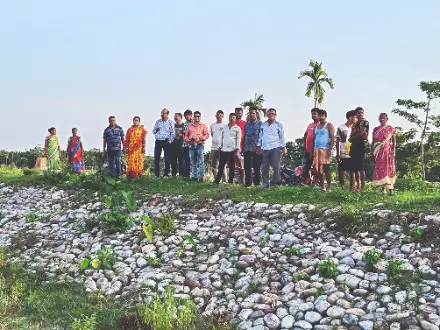Relentless rains stall flood-control projects in North Bengal region

Jalpaiguri: Continuous pre-monsoon rainfall triggered by low-pressure systems has severely disrupted flood-control operations across North Bengal, placing the Irrigation Department in a challenging position ahead of the monsoon season.
According to department sources, incessant rain in the upstream regions of Sikkim and Bhutan has significantly hampered ongoing work such as embankment repairs and erosion control along key rivers — Teesta, Sankosh, Raidak, and Torsha. In the Jalpaiguri district, embankment restoration along the Teesta near Milanpally, Biren Basti, Maynaguri, Kranti, and Odlabari is nearing completion. While rainfall in the plains has been relatively light, the persistent downpour in the hills has caused the Teesta’s water level to rise, delaying critical activities. “Once the rainfall subsides, the remaining work will be completed promptly,” said Krishnaendu Bhowmik, Chief Engineer of the Irrigation department’s North-East Division. In Alipurduar’s Kumargram block, a 500-meter stretch of the Sankosh embankment near Bittibari on the Bhutan border was recently repaired. An additional 750 meters of embankment strengthening, estimated at Rs 1 crore, has been postponed due to adverse weather.
Preparatory work on the Dima River in Kalchini has also been delayed, with plans to resume during the next dry spell. Cooch Behar district is facing similar setbacks. Projects along the Torsha, Kaljani, and Teesta rivers — in locations such as Jhawlkuthi, Mekhliganj, Char Balabhut, and Solar Danga — remain on hold due to continuous rainfall. “Consistent rain in Sikkim, Bhutan, and Assam, coupled with local showers, is keeping river levels elevated. We are monitoring the situation closely and will resume work as soon as conditions permit,” Bhowmik added.
Last week, the department conducted a pre-monsoon preparedness meeting in Jalpaiguri, bringing together engineers from Alipurduar, Cooch Behar, Jalpaiguri, and Siliguri. Reports of rain-related delays prompted the Chief Engineer to begin field inspections across the affected districts. Meanwhile, the regional Flood Control Room is set to be operational from June 1. Although efforts are underway to complete remaining work in time, the ongoing low-pressure system throughout May raises serious concerns about meeting deadlines before the onset of heavier monsoon rains.



